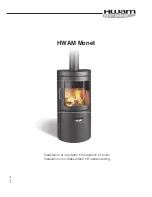
Commissioning - Page 20
3.3
Initial Lighting
(Fig. 20)
WARNING:
Before operating the appliance, check that the
air box covers are correctly fitted. The outer white front case
should be left off for the time being. Carry out the following
procedure in the order listed.
a)
Thoroughly flush out the whole of the heating system
with cold water.
b)
Fill and vent the system until the pressure gauge
registers 1.5 bar (21.5 psi), examine for leaks and
rectify. Do not overtighten joints. During filling ensure
that the plastic screw on top of the automatic air vent is
not tight and air can escape.
Do not tighten the air
vent screw after filling
. To ease filling an air bleed
valve (Fig. 16, Page 17) is fitted to the diverter valve
which must be opened until water flows out. The valve
should then be closed.
c)
Check the operation of the pressure relief valve by
further raising the water pressure until the valve lifts.
This should occur at approx. 3 bar, indicated on the
appliance pressure gauge. If installing in a low pressure
area (below 3 bar) fill to the maximum pressure
possible.
d)
Release water from the system using the pressure relief
valve until the minimum system design pressure is
reached. (Generally 1.0 bar). To allow maximum central
heating expansion capacity the pre-charge pressure in
the central heating expansion vessel must be marginally
greater than the initial (cold) system pressure at the
appliance. If the position of the appliance in the system
will cause the pressure at the appliance to be greater
than 1 bar (14.5 lb/in) increase the pre-charge pressure
in the central heating expansion vessel to a marginally
greater value prior to filling the system. Set the red
pressure gauge indicator to coincide with this pressure.
Check the pump spindle is free to rotate by unscrewing
the black octagonal nut, withdraw to engage the motor
spindle. The knob should rotate freely. The pump will
normally self vent the air from the rotor chamber and
bearings within a short while of switching on, however
should manual venting be required, sideways pressure
should be applied and maintained to the knob until a
small amount of water becomes visible. The manual
restart knob should now be screwed back to its original
position, finger tight.
e)
Check that the boiler switch is set to Stand-by and the
central heating switch is set to the Off position. (Mid
position)
f)
Check that the Hot Water and Central Heating
temperature controls on the control panel are set to their
lowest setting.
g)
Check the Gas service cock is On.
h)
Check that the boiler isolating valves and radiator valves
are open.
i)
Check that any time controls are in an On condition,
and any room thermostats are calling for heat.
j)
Switch On the main electricity supply to the
combination boiler at the wall isolating switch. The
Mains light will now illuminate.
k)
Loosen or remove the outlet (burner) pressure test
point screw in the gas valve body (Fig. 29), and
connect via a flexible tube to the + or Hi side of
pressure gauge. Then connect the - or Lo side of
pressure gauge via another flexible tube to the
pressure test point in the base of the inner casing.
(Fig. 20)
On Permanent Pilot version only, light the pilot:
i.
Press control knob in lightly and turn. Align Off position
with marker
.
ii.
Press control knob in lightly and turn. Align ignition
position
with marker
.
iii.
Press control knob in firmly and hold, at the same time
press the ignition button. The pilot flame should be
visible at the pilot window. If not press the ignition
button until the flame is established.
iv.
When the flame is established hold the control knob in
for approximately 20 seconds before releasing. The
pilot flame should remain alight.
v.
Press control knob in lightly and turn, align full flame
position
with marker
.
l)
Switch the Boiler switch to On.
Adjusting the Central Heating Range Rate Pressure.
See boxed Warning on page 21.
This pressure can only be measured in the central heating
mode.
(i)
Ensure all D.H.W outlets are turned off.
(ii)
Ensure all radiator control valves are fully open and any
room thermostats are calling for heat.
(iii)
Set central heating temperature control knob to
maximum.
(iv)
Set central heating switch to Constant. The burner will
now light but remain at low burner pressure for
approximately 2 minutes. After this time it will go to
maximum pressure. Allow the central heating to run for
5 or 10 minutes.
(v)
Using the range rate adjustment knob on the electronic
control board (Fig. 30) adjust to the values for Range
Rate in Table 4 on page 22.
m)
Turn the Hot Water temperature control clockwise to its
maximum setting.
n)
Fully open a hot water tap. (After a short delay the main
burner will light (on electronic versions the flame light
will illuminate.
Summary of Contents for 80e
Page 5: ...Optional Extras Page 5 ...
Page 6: ...Optional Extras Page 6 Installation instructions included as necessary with each kit ...
Page 7: ...Optional Extras Page 7 Installation instructions included as necessary with each kit ...
Page 12: ......
Page 28: ...Routine Maintenance Page 27 ...
Page 30: ...Routine Maintenance Page 29 ...
Page 34: ...Component Replacement Page 33 ...
Page 35: ...Component Replacement Page 34 ...
Page 43: ...7 1 Control Flow Sequence Permanent Pilot Page 42 ...
Page 44: ...7 2 Functional Flow Permanent Pilot Page 43 ...
Page 45: ...7 3 Fault Finding Permanent Pilot Page 44 ...
Page 46: ...7 4 Electrical Diagram Permanent Pilot Page 45 ...
Page 47: ...8 1 Control Flow Sequence Electronic Page 46 ...
Page 48: ...8 2 Functional Flow Electronic Page 47 ...
Page 49: ...8 3 Fault Finding Electronic Page 48 ...
Page 50: ...8 4 Electrical Diagram Electronic Page 49 ...
















































